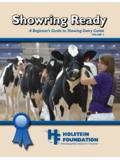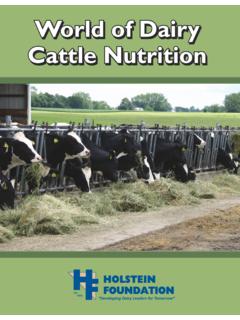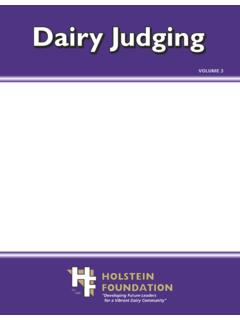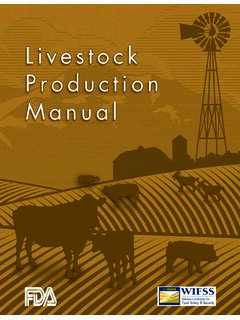Transcription of Milking and Lactation - Holstein Foundation
1 Holstein Foundation , Inc. 1 Milking and Lactation Developing Future Leaders for a Vibrant Dairy Community Milking and LACTATIONNOVEMBER 2017 Holstein Foundation , Inc. 3 4 Understanding Lactation 5 Functions of the Udder 8 Lactation Curve Stage 1 Stage 2 Stage 3 Dry Period 9 Metabolic Diseases 10 Functions of Hormones 11 Milking 14 Milk Quality 15 Mastitis 16 Milking Equipment 17 Milking Systems 20 ExercisesTable of Contents4 Milking and LACTATIONU nderstanding LactationLactation is the period of time that a mother secretes milk from her mammary glands. The Lactation cycle is the period between one calving and the next. The cycle is split into phases; the early, mid Lactation , late Lactation and the dry period.
2 In an ideal world, cows calve every twelve months, as they must calve in order to be able to produce milk. A dairy cow is a mammal. Mammals are animals that have hair, are warm-blooded and nourish their young with milk. The mammary gland of a cow is a fascinating structure. Mammary glands develop prior to birth and further develop and grow when the cow is pregnant. We commonly refer to the mammary glands of a cow as the udder. These skin glands are located on the underside of the cow, between the rear legs. The four glands are referred to as quarters. Several factors play a role in determining how much milk a cow will give such as age, breed, genetics and the environment. The average Holstein cow produces 9 gallons or 75 pounds of milk per day. However, the range can vary from 4 to 11 gallons a day.
3 On average cows produce 90 glasses of milk per day. A cow should spend 10 to 14 hours a day lying in the stall resting and making milk. Moderate exercise is important to maintain high milk production. Mature cows produce about 25% more milk than two-year-olds. Milk production increases until about eight years of age. Holsteins are the most prominent breed of dairy cattle producing around 23,000 pounds of milk a year. Approximately 400 to 500 gallons of blood pass through the udder for each gallon of milk produced. One of the roles of the mammary gland is to take nutrients from the cow s blood and synthesize them into milk that is then secreted into the mammary gland. At the end of pregnancy these glands undergo a process that initiates milk secretion. The production of milk requires that a cow be in Lactation , which is the result of giving birth.
4 Gestation is around 279 days, when the majority of mammary development occurs. The actual Lactation begins at calving. It doesn t only involve the production of milk, but also the development and function of the mammary gland, the metabolic and reproductive status of the cow and the development of the calf. Hormones and the removal of milk from the udder are the two key components that contribute to the maintenance of Lactation . In order for Lactation to begin again the cow must be bred to produce calves each year. Therefore, Lactation is the result of having a successful reproductive program. Colostrum is the first milk produced by the cow after calving. The composition of colostrum is different from that of normal milk as it contains higher concentrations of antibodies.
5 UDDER SUSPENSION & DIVISIONSUDDER ANATOMY SUPPORTIVE TISSUEH olstein Foundation , Inc. 5 Functions of the UdderMilk is a major source of nutrition and is composed of water, lactose, fat, proteins, minerals and vitamins. Milk is produced by cells grouped as hollow spheres and tiny storage units called alveoli (singular: alveolus). They appear as sac-like structures and are lined with epithelial cells. Epithelial cells are secretory cells that produce milk during Lactation . Within each mammary gland are millions of alveoli. Since there are many alveoli, all the milk that has been secreted from the cells into the alveoli empty into ducts and subsequent larger ducts which further lead to the gland cistern. The orifice, streak canal and cistern are all parts of a cow s teat.
6 The orifice is the opening to the papillary duct; normally held closed by the sphincter muscle in the wall of the teat and elastic tissue around the orifice. Invasion through the orifice is the primary route in most cases of mastitis. The streak canal is located at the end of each teat. The canal is to inch in length and is made up of extensions of the skin that lie close together. The streak canal is held closed by sphincter muscles. The streak canal prevents the escape of milk between milkings and acts as a barrier to the entry of bacteria. The teat cistern is the final storage area of milk before the cow is milked. The gland cistern joins to the teat cistern at the base of the udder. It is located just above the teat cistern and acts as a milk reservoir.
7 The gland cistern is the largest storage area for milk as it collects milk from the major milk ducts that flow into it and fills rapidly during milk letdown. The teat cistern is the cavity inside the teat that holds to 1 ounces of milk. The teat cistern is where milk accumulates before it is removed through the teat end during Milking . It refills continuously during Milking . 6 Milking and LACTATIONIn the internal milk production process, epithelial cells starts to replenish the milk supply immediately at the end of Milking . The reduced udder pressure increases the blood flow allowing for the high rate of production. The hormone prolactin is present to stimulate the epithelial cells. The supramammary lymph glands or nodes act as filters that destroy and remove bacteria from the udder.
8 The streak canal is the main barrier against intramammary infection. It is kept closed by a ring shaped muscle at the lower end of a cow s teat called the sphincter. When a cow is milked this causes the sphincter muscles to relax, opening the orifice. The streak canal actually remains open an hour after Milking , so it is important to help prevent bacteria from teat end contamination. The cells that line the streak canal contain keratin. Keratin is a waxy substance similar to ear wax. This substance helps to seal the teat end between milkings and inhibits the growth of CANAL AND LINING OF KERATINH olstein Foundation , Inc. 7 UDDER ANATOMY INDIVIDUAL TEATUDDER SUSPENSIONThe F rstenburg's rosette is located directly above the streak canal. It is made up of loose folds of membranes that smooth out as milk accumulates in the udder.
9 This aids in blocking the escape of milk between most important support for the udder is the median suspensory ligament. The median suspensory ligament is located at the center of the udder providing a balanced suspension. It divides the udder into left and right halves. This major ligament has the ability to stretch as the gland fills with milk. Subcutaneous mammary veins also known as milk veins emerge at the front of the udder and run along the abdominal cavity and re-enter the body at the milk wells. Swelling of the udder is known as edema and is common at calving because a cow s udder has poor blood one teat drains one gland of the dairy cow. Almost 50% of calves are born with extra teats, often called supernumerary teats. Extra teats need to be removed before an animal reaches one year old.
10 Many recommend removing extra teats as early as two weeks old. Sometimes cows will have a blind quarter. This is when one of the quarters does not secrete Milking and LACTATIONL actation Curve Often a cow s Lactation cycle is referred to in stages: early Lactation , mid Lactation , late Lactation and the dry period. Nutrient requirements will vary with the stage of Lactation and gestation. Your nutrition program can play a critical role in milk production and reproductive performance. Milk production will start suddenly and increase daily in early Lactation . As this happens greater amounts of nutrients are needed. Mammary tissue function declines after peak Lactation mainly due to the decrease in mammary cell quantity. It is common to group cows according to their stage of Lactation in group housing facilities.











